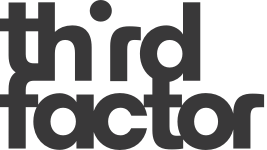Mel Davidson
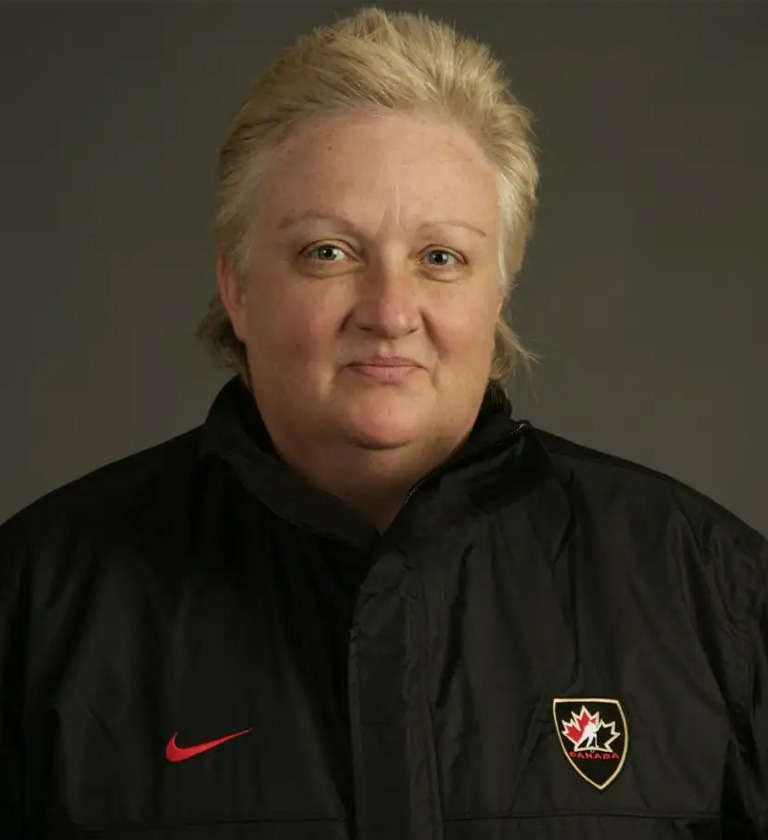
Mel Davidson is a legend in women’s hockey, having led Team Canada to Olympic gold as head coach in 2006 and 2010 and as general manager in 2014. Across 36 international events, every team she’s led has reached the podium—a testament to her leadership and consistency under pressure. Today, Mel is a high-performance advisor with Own the Podium, supporting national team programs across Canada. Her expertise in team dynamics and coaching strategy, along with her no-nonsense approach to performance, is a major asset to the board.
Debbie Low

Debbie Low is President and CEO of the Canadian Sport Institute Ontario (CSIO), where she has transformed the organization into a national leader in athlete development. Her background spans leadership roles across parasport and major games, including serving as Chef de Mission at the 2008 Paralympics. Recognized for her impact on sport and inclusion, Debbie brings a strategic lens and deep systems knowledge to our advisory conversations.
Jesse Lumsden
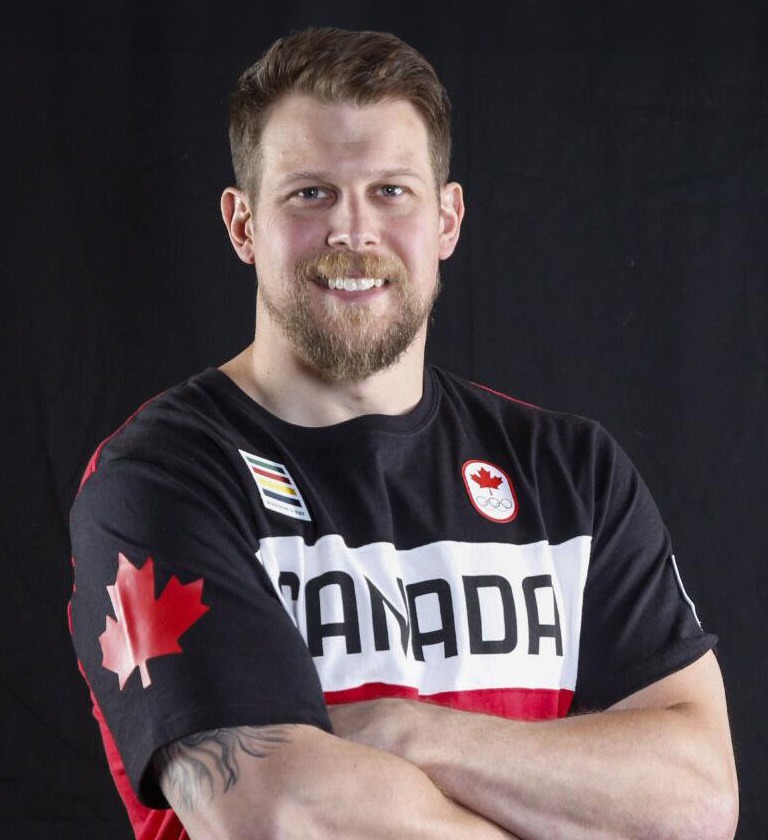
Jesse Lumsden is a dual-sport athlete and rising leader in Canadian high-performance sport. After a successful CFL career as an all-star running back, Jesse transitioned to bobsleigh, representing Canada in three Olympic Games and earning World Championship medals. Today, he serves as High Performance Director for Bobsleigh Canada Skeleton. Jesse brings firsthand experience of high-stakes competition and athlete transition—along with a deep commitment to developing performance cultures that last.
Tracy Wilson
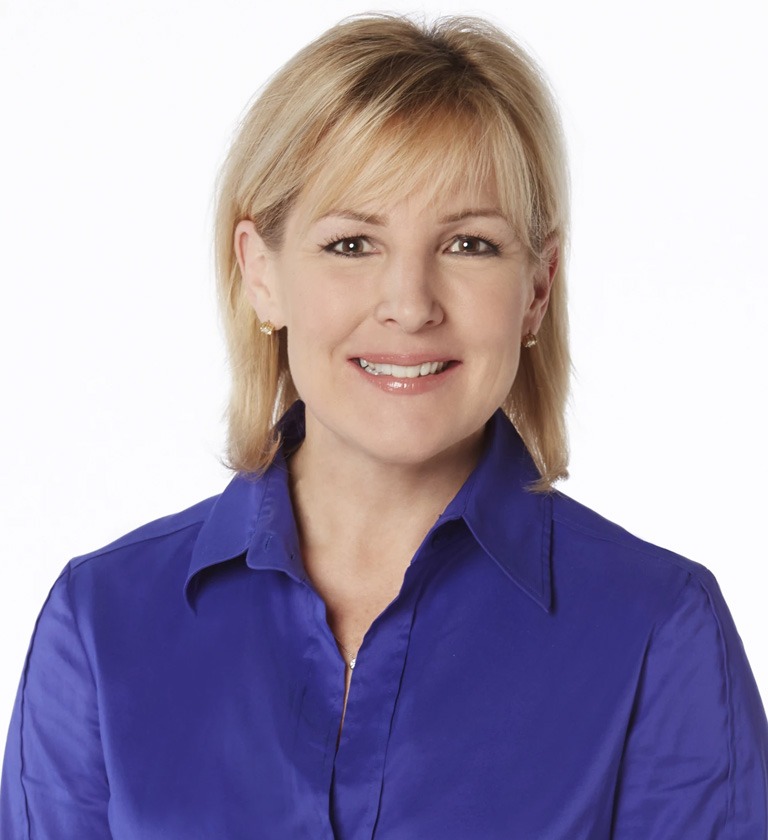
Tracy Wilson is an Olympic bronze medalist, broadcaster, and one of Canada’s most respected figure skating coaches. Alongside her late partner Rob McCall, she won seven consecutive national titles and the pair made history as the first Canadian ice dancers to reach the Olympic podium. Today, Tracy is a leading coach alongside Brian Orser at the Toronto Cricket Skating and Curling Club, working with Olympians like Yuzuru Hanyu and Javier Fernández. Her blend of technical mastery and focus on mindset makes her a powerful contributor to our advisory board.
 Here are three lessons from Rosie’s talk that can help anyone striving for their own version of a gold-medal performance.
Here are three lessons from Rosie’s talk that can help anyone striving for their own version of a gold-medal performance.
1: Confront failure head-on
One of Rosie’s most interesting insights was slightly counter-intuitive: when the fear of failure is strong, don’t shy away from it – lean into it. Ahead of the Olympics, Rosie consciously worked to confront the possibility of failure directly, and work through her worst-case scenario in vivid detail.“By confronting the possibility of failure, you can free yourself from its grip.”In partnership with her mental performance coach, Rosie sat down and played out two scenarios: what if things go well and I win? And, what if I stumble and fail? With these two scenarios in mind, she vividly worked through how she would feel and what her life would be like: 1 day after, 1 week after, 1 month after, 1 year after, and, eventually, 5 years post-Olympics. Rosie’s realization? Ultimately, the outcome at the Games would have little impact on her life 5 years down the road. Regardless of the outcome she would be okay. This mental exercise allowed Rosie to remove the distraction of fear from her preparation. By confronting failure head-on, she could redirect her energy from worrying about what could go wrong to focusing on what she could control. Whether you’re preparing for a major presentation, launching a new business venture, or pursuing a personal goal – instead of trying to avoid thinking about failure, take the time to visualize the negative scenario. When we “play out the full movie” what we often find is that the fear comes from the fact that we are just imagining a moment in time – an incomplete thought or image that doesn’t reflect the fullness of time. By confronting the possibility of failure, you can free yourself from its grip and focus entirely on performing at your best.
2: Embrace direct feedback
Rosie’s coach, Dave Ross, is known for a style that is extremely candid. While some athletes balked at his bluntness, Rosie saw something deeper: a genuine commitment to helping her succeed. She understood that behind his straightforward critiques was a profound belief in her potential. Instead of resisting his feedback, she consciously worked to lean into it, using it as information to unlock higher levels of performance. This ability to harness the value in blunt feedback came from her taking the time to understand Dave as a person. She took the time to look beyond personality and style to understand his values and ultimately his character. These insights didn’t just unlock her own performance, they also allowed her to help other athletes shift their perspective on Dave’s feedback by sharing her insights into what was behind his style. When you find yourself chafing at direct feedback, consider the intent of the person delivering it. Where are they coming from? What are they trying to help you accomplish? Often, others are trying to help – even when their wording or approach might trigger some reactivity.3: Use visualization to overcome obstacles
In the lead-up to the Tokyo Olympics, Rosie faced a daunting challenge: a series of serious ankle injuries that left her unable to perform her trampoline routine for weeks. In fact, she was unable to practice her full routine until one day before leaving for the Games.“When we imagine something with enough vivid detail – to our body, it’s real.”Rather than letting this setback derail her preparation, Rosie turned to the power of imagery and visualization. Unable to train physically, she trained mentally. This started with simply imagining herself bouncing on the trampoline again. She shared that, initially after the injury, every time she would close her eyes and visualize jumping on the trampoline – she would see herself falling. With effort and (mental) practice, she was able to start to imagine herself jumping with confidence, and eventually to visualize her entire routine in vivid detail. Remarkably, Rosie finished 4th at the Tokyo Olympics— less than a single point off of the podium featuring the best athletes on the world, all of whom had been training regularly, despite having been unable to physically practice until a single day prior to travel. When we imagine something with enough vivid detail – to our body, it’s real. Some studies estimate that for elite athletes, mental rehearsal delivers roughly 85% of the benefits of physical rehearsal. Rosie’s experience certainly backs up that research. Visualization isn’t just for elite athletes. It’s a tool anyone can use to prepare for high-stakes situations —whether it’s a speech, negotiation, or exam—spend time visualizing your performance. Imagine every detail: the environment, your actions, and the desired outcome. This mental preparation can help you feel more confident and prepared when the moment arrives.
Bringing it all together
Rosie MacLennan’s journey to Olympic success is more than a story about athletic achievement. Her approach to confronting failure, embracing feedback, and harnessing the power of visualization provides lessons that can help all of us. Here’s a challenge: think about your own version of a “gold medal performance.” What are you striving for in your career, relationships, or personal growth? Now, consider how you can apply Rosie’s three strategies: Confront failure head-on: What’s holding you back? Imagine the worst-case scenario to start to rob it of its power. Embrace direct feedback: Who in your life is pushing you to be better? How can you listen with an open mind and use their insights to grow? Use visualization to your advantage: What mental rehearsals can you do to prepare for your big moment? At Third Factor, we are sad to learn that Team Canada will not be competing at the Tokyo Olympic and Paralympic Games this summer. At the same time, we are also incredibly proud of the Canadian Olympic and Paralympic Committees for taking the lead and making the right decision for the health and safety of Canada’s athletes, coaches, staff, volunteers and fans. The chaos, challenges and health risks posed by COVID-19 make the decision to withdraw from the Games a necessary one. Athletes are unable to train. Coaches and support teams cannot properly plan. Travel is unavailable and unsafe for family members and other attendees. And the sponsors that support athletes and teams are now unable to proceed with their marketing efforts without risking the appearance of being insensitive and out-of-touch given the current reality.“We stand ready to support our athletes, coaches and leadership organizations through the coming months and in Team Canada’s inevitable return to Olympic competition.”By withdrawing Team Canada from the Tokyo Games, the COC and CPC have made an important statement that this crisis is bigger than the Olympic and Paralympic Games and that our collective health and safety should be our only priority over the coming months. They have also given a clear answer to the athletes who have been tortured by uncertainty and were wondering whether they would have a chance to compete and, if so, whether they would have to risk their health in order to do so. We join the COC and CPC in calling on the International Olympic and Paralympic Committees to postpone the Tokyo Games by one year so that all members of the international community may focus on their physical, mental and financial health, caring for loved ones, and doing their part to stop the spread of COVID-19. For the last three decades, our organization has been proud to support the Olympic community in Canada. We stand ready to support our athletes, coaches and leadership organizations through the coming months and in Team Canada’s inevitable return to Olympic competition. Signed, Dane Jensen, Peter Jensen, Sandra Stark, Peggy Baumgartner, Garry Watanabe & Cyndie Flett on behalf of the entire team at Third Factor.
Editor’s note: Since publishing, we have learned that the IOC has officially postponed the start of the Tokyo Games.
This Friday marks the 10-year anniversary of the Closing Ceremonies of the Vancouver 2010 Olympic Games. Here at Third Factor, we were incredibly proud to directly and indirectly support many of the athletes and coaches that would go on to become household names. Ten years later, we are still committed to supporting Olympic and Paralympic athletes and coaches in their bid for the podium. And three incredible stories from the 2010 Games continue to influence our understanding of the power of pressure and the way we interact with our clients across all areas of our business.Changing a Canadian mindset
Prior to the Vancouver Olympics, Canada was known in Olympic circles for one notable achievement: it was the only nation in the world to host the Games without a local athlete winning gold. In fact, Canada had achieved this feat twice; first at the 1976 Summer Games in Montreal, and again at the 1988 Winter Games in Calgary. When Vancouver won the bid to host the 2010 Winter Games, Canada’s 13 winter national sport organizations were determined to change that reputation. A report by sport management consultant and Olympic Hall of Famer, Cathy Priestner Allinger, found that Canadian athletes ranked top-five in the world the year before the games were far less likely to go on to win an Olympic medal than international athletes who were performing at the same level.“Canada’s challenge wasn’t producing world-class athletes; it was producing world-class athletes who could perform with all the distractions and pressure of the Olympics”In other words, Canada’s challenge wasn’t producing world-class athletes; it was producing world-class athletes who could perform with all the distractions and pressure of the Olympics. Brian Orser was one of Canada’s star athletes at the Calgary Games in 1988, and he spoke to us about the pressure of competing in front of a home crowd. To help Canada’s performers prepare for the pressure of Olympic competition, the not-for-profit organization Own the Podium was formed to provide and fund support structures designed to give Canadian athletes the preparation that would allow them to access their best performances in the face of Olympic pressure. Own The Podium was a spectacular success. At Vancouver, Canadian athletes won 26 medals, including a record-setting 14 gold medals, placing Canada third overall. Since that time, Canadian athletes have been ‘converting’ at a rate of around 70% and Canadians now enter Olympic Games with an expectation that they could indeed, be the best in the world.
The impact of self-awareness and communication strategies
We had always believed that self-awareness was a critical component of team performance, and there was no doubt on the subject following our work with the Canadian Women’s Olympic Hockey Team at the Vancouver Games. In 2010, the team was looking to defend its gold medal from the Turin Games four years prior. They were also preparing to face their American arch-rivals who had bested them at the world championship the year before. As the team’s mental performance coach, Third Factor Founder, Dr. Peter Jensen, was tasked with helping the team perform through the high-stakes tournament while under intense scrutiny from the home crowd. To help keep the team running like a finely tuned engine, he elected to bring in our collaboration guru, Peggy Baumgartner, to guide the team through our Self-Aware Team process. Through the program, the team was able to gain a better understanding of their tendencies – both individually and as a team under pressure. And, they leveraged that new understanding to design systems to keep communication flowing effectively when the pressure mounted. The players remember it as a challenge that was both extremely difficult, and extremely worthwhile. With a strategy in place, the team was able to communicate and stay consistent whether things were going well or poorly. They were able to work their way through the ups and downs of Olympic competition and successfully defend their gold medal on home ice. What we learned is that when you have a high functioning team – even one that’s among the best in the world – one of the most powerful ways to further enhance their performance is to increase their self-awareness and communication skills.The convergence of health and performance
For us at Third Factor, there was a hidden storyline we were following that was far more significant than the Olympics. One week prior to the start of the Games, Peter Jensen was with the Women’s Olympic Hockey Team in Jasper, Alberta, at their pre-Olympic camp when he received confirmation that he had throat and neck cancer.“Peter had to keep the information from the team so as not to become an enormous distraction”Peter had to notify the leadership at Hockey Canada and, with their blessing, continued to support the mental performance of the Women’s Olympic Hockey Team. As they headed into their most important competition of the four-year cycle, Peter had to keep the information from the team so as not to become an enormous distraction while simultaneously teaching skills, being at his best and dispensing regular doses of his usual sense of humour. Peter is currently cancer-free and maintains a crazy busy schedule delivering keynote speeches to audiences big and small around the world. Peter wrote about his experience in his own words in his whitepaper, When Health and Performance Converge: What I (re)Learned From Cancer. It’s a great read if you’re curious to learn more about how he was able to stay resilient through such a difficult time. To those of us at Third Factor, the 2010 Vancouver Games are a reminder that Peter doesn’t just teach people how to handle pressure, he lives and breathes the content. In 2002, the Canadian Women’s National Hockey Team entered the Olympic Games in Salt Lake City in an unfamiliar position: as underdogs. They had not hit their stride as a team, their confidence had taken a hit, and emotions were at risk of boiling over. In eight head-to-head games against the Americans leading up to the Olympics, Canada had lost all eight. For many players, it was hard to avoid memories from four years earlier when the team had lost to the Americans in the gold medal game. Jayna Hefford, who was playing in the first Games of her Hall of Fame career, recalls the point when the stress and emotion came to a head: “There was an intense conversation in the dressing room with the team. A lot of people had a lot to say about things we needed to do and how we were going to get better, and we realized that a lot of what was happening was the blame game.”
“We realized that a lot of what was happening was the blame game.”Through a frank, players-only discussion the team was able to come together, but the conversation could have gone a number of different ways. It stayed on track because the team was prepared – mentally and emotionally – to have performance conversations under pressure and surface a number of issues the team needed to resolve. And that preparation turned out to be an important stepping stone to winning gold in Salt Lake City.
Training the bomb squad
Handled poorly, team communication under pressure can lead to combustion. And just like you wouldn’t get success as a bomb disposal technician going in without their toolkit, you won’t find success in communicating through tense situations if your team isn’t prepared. The advantage the women’s team had that allowed them to emerge from that conversation united was a deep awareness of their communication tendencies and systems to counteract the counterproductive ones. They had laid the foundation for performance conversations in good times so that they could happen and be productive when the difficulty hit. In other words: they had a tool kit and they knew how to use it.“The biggest opportunity for meaningful growth is often to increase self-awareness and strengthen their ability to communicate productively when under pressure.”We’ve worked with hundreds of teams in elite sport and business, including the last four medal-winning Canadian women’s hockey teams. One of the things we’ve learned is that when teams are already operating at a high level, the biggest opportunity for meaningful growth is often to increase their self-awareness and strengthen their ability to communicate productively when under pressure. To support this, we’ve developed a process to help teams become more aware of their tendencies, develop systems and practice performance conversations anytime. At the heart of this process is a tool called the TAIS – The Attentional and Interpersonal Styles inventory. The TAIS was developed for use by Navy SEALs and Olympic athletes, and we’ve found it to be an incredibly valuable tool for diagnosing communication challenges on all kinds of teams. When the pressure is on, when teams are in the midst of setbacks and failure, individuals will fall back on their default communication styles.
Five communication choices
The author of the TAIS, Dr. Robert Nidefer, showed that people make five choices over and over in the course of a conversation. These choices are informed by their tendencies on five dimensions.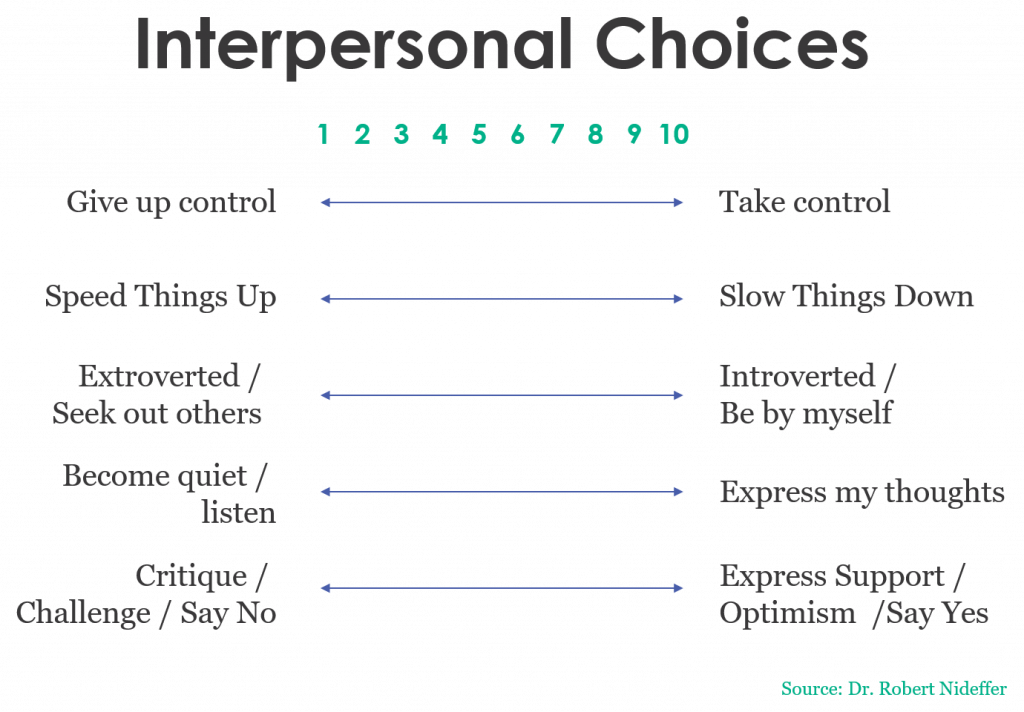
Cut the right wire
Every team will have members with different tendencies. Ultimately, it’s not the tendencies that matter; it’s the level of awareness team members have of their tendencies, and the systems they put in place to leverage their strengths and weaknesses in the heat of the moment. The highest performing teams we work with take three critical steps in preparing for productive communication under any circumstances.Acknowledge the “I” in team
Great coaches know that the phrase “there is no I in team” is a myth. Every individual makes their own contribution – and without self-awareness, people can’t adjust. That’s why the first step in your team’s communication action plan is to encourage every individual to build self-awareness across these five choices. By knowing and understanding their default tendencies, team members can begin to recognize their behaviour and course-correct when necessary for the good of the team.Connect to the “we” of the team
It’s advantageous to know your individual tendencies, and the value is multiplied when that information is shared with everyone on the team. When you raise the waterline of team awareness, everyone can work on the same communication system. Team members can see the intent behind the behaviors their teammates exhibit. The process can be incredibly difficult; Team Canada Captain Hayley Wickenheiser called sharing her profile with her team-mates, “the most stressful part of the 4-year [Olympic] quadrennial.”Come together as a team
Armed with knowledge of self and others, teams can come together and translate self-awareness into action. When pressure hits, if everybody on the team has the tendency to get louder, express their thoughts and try to take control of the conversation, the team can make decisions in advance to decide who’s going to take control when issues arise. By having these conversations earlier, teams can build systems to fall back on when the pressure is turned up.Preventing detonation
The next time you’re headed into a potentially high stakes conversations, use the five choices below to carry out a short 3-step preparation exercise:

1. Plot your default tendency on each of the five scales – given your past history, where are you most likely to fall?
2. Where would you ideally like to be as you head into this specific interaction?
3. What are the gaps between your ideal and default style? What actions will you take to ensure you are at your ideal?
Repurpose the fuel for growth
We’ve said before that negative emotion is volatile fuel. Improperly handled, it can lead to combustion. Used properly, it can lead to high performance. Team communication must go beyond just staying cool during difficult times. Teams must use communication to understand and lean in to their negative emotions, uncover what the emotions are telling them, and frame it as an opportunity for growth. This is what happened with the women’s team in 2002. They prepared to have productive communication at all times, and used the tools they learned to find the opportunity for growth at a moment when it could have blown up. Jayna Hefford explains: By understanding your individual communication style, sharing your tendencies with the team and proactively planning to address potential faults, your team can find its way through difficult times and not just safely diffuse difficult situations but find new strength and opportunity for higher performance in the process. When the trajectory of your life hangs in the balance of one critical moment – when your heart is racing, your palms are sweaty, and your breathing is ragged – how do you nail it? Few people are better qualified to answer this question than Olympic skating legends Brian Orser and Tracy Wilson. As athletes, they carried the weight of a nation at the 1988 Olympic Games in Calgary – entering as a reigning world champion and 7-time Canadian champion, respectively. Competing in front of a home crowd with incredibly high expectations, Brian and Tracy won 2 of Canada’s 5 medals in Calgary. Today, Brian and Tracy are coaches to a new generation of elite skaters from around the world at the Toronto Cricket Club. They’ve produced gold medalists for the last 3 Olympic games and currently coach the reigning Olympic men’s champion, Yuzuru Hanyu of Japan, and the reigning Olympic women’s silver medalist, Evgenia Medvedeva of Russia. As athletes and coaches, Brian and Tracy have delivered exceptional performances in moments of intense pressure. In this video series, they shine some light on their experience performing under pressure and coaching athletes to perform under pressure, and reveal simple strategies you can use to be at your best in your own most critical moments.Brian Orser describes the media frenzy and inescapable layers of pressure he felt leading up to the ‘Battle of the Brians’ on home ice at the 1988 Calgary Olympics.“There was a media frenzy”
Tracy Wilson shares how she practiced the emotional moments in advance of competition at the 1988 Olympic Games in Calgary.“What got me so excited was representing Canada”
Brian Orser talks about how he established and practiced routines for any situation, whether he had to skate first or wait around to skate 6th.“We were prepared for any scenario”
Tracy Wilson explains how leaning into emotions can help performers diffuse tension and how coaches can use communication to help their team members perform at critical moments. What do elite athletes know about resilience? They know that it is largely an inside job. In the face of adversity, disappointment, and set-backs, Olympic athletes take on the role of Power Converters: they harness the energy inherent in pressure to enhance their own performance. Here’s the good news: you too can learn to leverage pressure in order to generate better results. The necessary skills are not innate genetic gifts, but rather, abilities that can be consciously learned and practiced. Peter and Dane Jensen introduce the four skill sets that make up the personal resilience tool-kit used by elite athletes and high performers in business to gain control over how pressure and stress will impact performance. Click here to download the whitepaper. Upon hearing the ‘c-word’ from his doctor, Peter Jensen embraced teachings from the Inside Edge in order to equip him for the challenge ahead. Imagine if you got a phone call that would dramatically change your life for the next decade or more. How would you react? The mental fitness skills that are used to stimulate high performance on the field or in the boardroom have a distinct purpose in a more central area of our lives–our personal health. Click here to read the whitepaper.“I hate this part”
